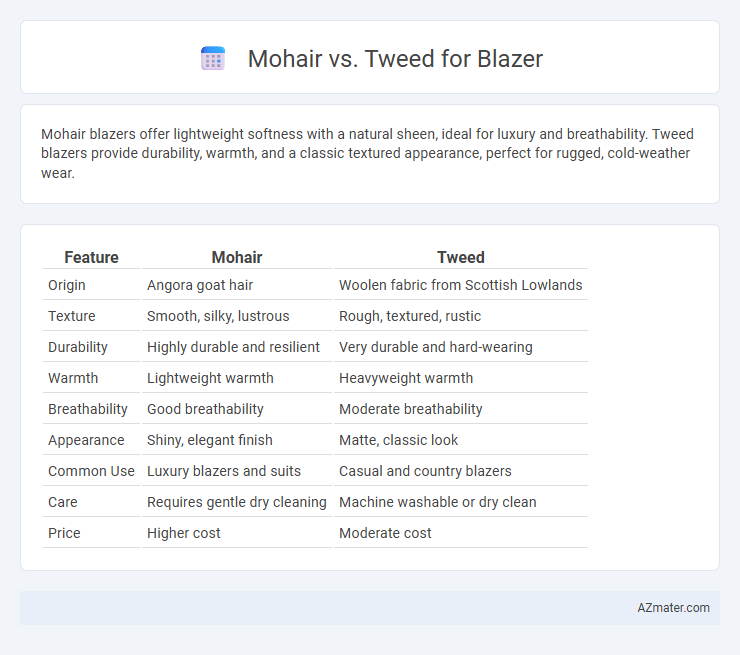Mohair blazers offer lightweight softness with a natural sheen, ideal for luxury and breathability. Tweed blazers provide durability, warmth, and a classic textured appearance, perfect for rugged, cold-weather wear.
Table of Comparison
| Feature | Mohair | Tweed |
|---|---|---|
| Origin | Angora goat hair | Woolen fabric from Scottish Lowlands |
| Texture | Smooth, silky, lustrous | Rough, textured, rustic |
| Durability | Highly durable and resilient | Very durable and hard-wearing |
| Warmth | Lightweight warmth | Heavyweight warmth |
| Breathability | Good breathability | Moderate breathability |
| Appearance | Shiny, elegant finish | Matte, classic look |
| Common Use | Luxury blazers and suits | Casual and country blazers |
| Care | Requires gentle dry cleaning | Machine washable or dry clean |
| Price | Higher cost | Moderate cost |
Introduction to Mohair and Tweed Blazers
Mohair blazers are crafted from the silky fibers of the Angora goat, offering a lustrous sheen and exceptional durability that enhances both comfort and style. Tweed blazers, made from rough, woolen fabric, provide a classic, textured look with excellent insulation, making them ideal for cooler climates. These distinctive materials influence the blazer's appearance, feel, and functionality, catering to different fashion preferences and seasonal needs.
Origin and History of Mohair and Tweed Fabrics
Mohair, derived from the Angora goat in Turkey and popularized in 16th-century Europe, is known for its silky texture and sheen, historically prized in fine tailoring. Tweed originates from the Scottish Lowlands in the 19th century, crafted from rough, unfinished wool designed to withstand damp climates, becoming synonymous with rugged, outdoor attire. Both fabrics possess rich heritages influencing their enduring popularity in blazer fashion for distinct style and durability.
Characteristics of Mohair Blazers
Mohair blazers are distinguished by their luxurious sheen, durability, and lightweight feel, making them ideal for both formal and casual wear. The fibers from the Angora goat impart a smooth texture and excellent breathability, providing comfort in varying climates. Mohair's natural resilience and wrinkle resistance ensure the blazer maintains a sharp, polished appearance throughout the day.
Key Features of Tweed Blazers
Tweed blazers are renowned for their durability, moisture resistance, and textured appearance, making them ideal for rugged, outdoor wear. Composed primarily of wool, tweed offers excellent insulation and breathability, ensuring comfort in cooler climates. Its distinctive herringbone or check patterns add timeless sophistication and versatility to both casual and formal ensembles.
Style and Aesthetic Differences
Mohair blazers exhibit a sleek, lustrous appearance with a smooth texture that enhances formal and sophisticated style, often favored for its subtle sheen and elegant drape. Tweed blazers showcase a rugged, textured fabric characterized by a rougher, woven pattern, imparting a classic, vintage-inspired aesthetic that emphasizes warmth and casual refinement. The choice between mohair and tweed blazers hinges on mood and occasion, where mohair suits polished, modern looks and tweed aligns with traditional, country-inspired fashion.
Comfort and Wearability Comparison
Mohair blazers offer exceptional softness and breathability, making them highly comfortable for prolonged wear in varying temperatures. Tweed blazers, made from coarser wool, provide greater durability and warmth but may feel heavier and less breathable during extended use. The choice between mohair and tweed for blazers depends on the desired balance between lightweight comfort and rugged wearability.
Durability and Maintenance
Mohair blazers offer superior durability due to the fiber's natural strength and resistance to wear and tear, making them ideal for long-term use. Tweed, made from dense wool, provides excellent durability as well but requires more careful maintenance to prevent pilling and moisture damage. Both fabrics demand regular brushing and proper storage, but mohair tends to resist wrinkling and shedding more effectively than tweed.
Seasonal Suitability: Mohair vs Tweed
Mohair blazers excel in spring and summer due to their lightweight, breathable fibers that offer moisture-wicking and temperature regulation. Tweed blazers provide superior warmth and durability, making them ideal for fall and winter with their dense wool composition that insulates against cold weather. Choosing between mohair and tweed for a blazer depends on seasonal demands, where mohair suits warmer months and tweed ensures comfort in colder climates.
Price and Value Considerations
Mohair blazers generally command higher prices due to the fiber's luxurious softness, sheen, and durability, making them a premium choice for sophisticated wardrobes. Tweed blazers, often crafted from robust wool blends, offer exceptional value with their classic texture and excellent warmth, ideal for versatile, everyday wear. While mohair emphasizes elegance and a polished finish, tweed provides cost-effective durability and a timeless rugged appeal, ensuring strong resale value depending on lifestyle needs.
Choosing the Right Fabric: Mohair or Tweed for Your Blazer
Mohair offers a luxurious sheen and lightweight feel, ideal for formal blazers that require breathability and elegance, while tweed provides durability and a textured, rugged aesthetic suited for casual or outdoor wear. Consider climate and occasion: mohair excels in warmer settings with its moisture-wicking properties, whereas tweed's thick wool fibers provide superior insulation during colder months. Selecting between mohair and tweed hinges on balancing style preferences with functional needs such as weather resistance, comfort, and intended use.

Infographic: Mohair vs Tweed for Blazer
 azmater.com
azmater.com